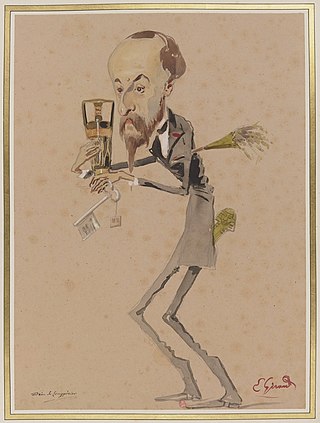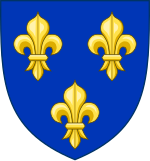
Barcelonnette is a commune of France and a subprefecture in the department of Alpes-de-Haute-Provence, in the Provence-Alpes-Côte d'Azur region. It is located in the southern French Alps, at the crossroads between Provence, Piedmont and the Dauphiné, and is the largest town in the Ubaye Valley. The town's inhabitants are known as Barcelonnettes.

The Pastry War, also known as the first French intervention in Mexico or the first Franco-Mexican war (1838–1839), began in November 1838 with the naval blockade of some Mexican ports and the capture of the fortress of San Juan de Ulúa in the port of Veracruz by French forces sent by King Louis Philippe I. It ended in March 1839 with a British-brokered peace. The intervention followed many claims by French nationals of losses due to unrest in Mexico. This would be the first of two French invasions of Mexico; a second, larger intervention would take place in the 1860s.

The Totonac are an indigenous people of Mexico who reside in the states of Veracruz, Puebla, and Hidalgo. They are one of the possible builders of the pre-Columbian city of El Tajín, and further maintained quarters in Teotihuacán. Until the mid-19th century they were the world's main producers of vanilla.

The French people are a nation primarily located in Western Europe that share a common French culture, history, and language, identified with the country of France.

Jean Meyer Barth is a French-Mexican historian and author, known for his writings on early 20th-century Mexican history. He has published extensively on the Mexican Revolution and Cristero War, the history of Nayarit, and on the caudillo Manuel Lozada. He is a faculty member at the Centro de Investigación y Docencia Económicas, and a Guggenheim Fellow.

Immigration to Mexico has been important in shaping the country's demographics. Since the early 16th century, with the arrival of the Spanish, Mexico has received immigrants from Europe, Africa, the Americas, and Asia. Today, millions of their descendants still live in Mexico and can be found working in different professions and industries.

Italian Mexicans are Mexican-born citizens who are fully or partially of Italian descent, whose ancestors were Italians who emigrated to Mexico during the Italian diaspora, or Italian-born people in Mexico. The ancestors of most Mexicans of Italian descent arrived in the country during the late 19th century. Their descendants have generally assimilated into mainstream Mexican society.

Spanish settlement in Argentina, that is the arrival of Spanish emigrants in Argentina, took place first in the period before Argentina's independence from Spain, and again in large numbers during the late 19th and early 20th centuries. Between the 15th and 19th centuries, the Spanish Empire was the sole colonial power in the territories that became Argentina after the 1816 Argentine declaration of independence. Thus, before 1850, the vast majority of European settlers in Argentina were from Spain and they carried the Spanish colonial administration, including religious affairs, government, and commercial business. A substantial Spanish descended Criollo population gradually built up in the new cities, while some mixed with the indigenous populations (Mestizos), with the Black African-descended slave population (Mulattoes) or with other European immigrants.

"A Drama in Mexico" is a historical short story by Jules Verne, first published in July 1851 under the title "L'Amérique du Nord, études historiques: Les Premiers Navires de la marine mexicaine."

The Liceo Franco Mexicano A.C. or the Lycée Franco-Mexicain is a private French school with three campuses. It is one of the largest French lycées in the world with over 3,000 students in its two Mexico City campuses: Polanco in Miguel Hidalgo in northern Mexico City, and Coyoacán in southern Mexico City. The third campus, École Molière de Cuernavaca is in the city of Ocotepec, Cuernavaca, Morelos.

Emmanuel-Henri-Dieudonné Domenech was a French abbé, missionary and author.

Spanish Mexicans are citizens or residents of Mexico who identify as Spanish as a result of nationality or recent ancestry. Spanish immigration to Mexico began in the early 1500s and spans to the present day. The vast majority of Mexicans have at least partial Spanish ancestry; the Northern regions of Mexico have a higher prevalence of Spanish heritage. There are three recognized large-scale Spanish immigration waves to the territory which is now Mexico: the first arrived during the colonial period, the second during the Porfiriato and the third after the Spanish Civil War.

French Brazilians refers to Brazilian citizens of full of partial French ancestry or persons born in France who reside in Brazil. Between 1850 and 1965 around 100,000 French people immigrated to Brazil. The country received the second largest number of French immigrants to South America after Argentina (239,000). It is estimated that there are around 1 million Brazilians of French descent today.

French Argentines refers to Argentine citizens of full or partial French ancestry or persons born in France who reside in Argentina. French Argentines form one of the largest ancestry groups after Italian Argentines and Spanish Argentines. Between 1857 and 1946, 261,020 French people immigrated to Argentina. Besides immigration from continental France, Argentina also received, as early as the 1840s, immigrants with French background from neighboring countries, notably Uruguay, which expanded the French Argentine community. In 2006, it was estimated that around 6 million Argentines had some degree of French ancestry, up to 17% of the total population.

Gabriel Ferry is the pen name of two French writers, father and son.

The Spanish diaspora consists of Spanish people and their descendants who emigrated from Spain. In the Americas, the term may refer to those of Spanish nationality living there; "Hispanic" is usually a more appropriate term to describe the general Spanish-speaking populations of the Americas together with those in Spain. The diaspora is concentrated in places that were part of the Spanish Empire. Countries with sizeable populations are Argentina, Bolivia, Chile, Colombia, Costa Rica, Cuba, Dominican Republic, Ecuador, El Salvador, Guatemala, Honduras, Mexico, Nicaragua, Panama, Paraguay, Peru, Uruguay, Venezuela, and, to a lesser extent, Brazil, Belize, Haiti, United States, Canada, the Philippines and the rest of Europe.

Henry Adrien Prévost de Longpérier was a 19th-century French numismatist, archaeologist and curator.

The musée mexicain, later musée américain, was a section of the Louvre that was dedicated to pre-Columbian art, with an initial emphasis on Mexican archaeology. It opened in 1850, and closed in 1887 when its collections were transferred to the Musée d'Ethnographie du Trocadéro.

Charles-Louis Du Pin was a French military man. He participated in the Second French intervention in Mexico, where he reorganized the local militia.
Belgian Mexicans are Mexican citizens of Belgian descent or Belgium-born people living in Mexico.



















